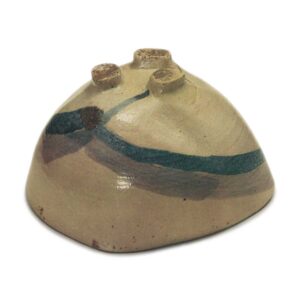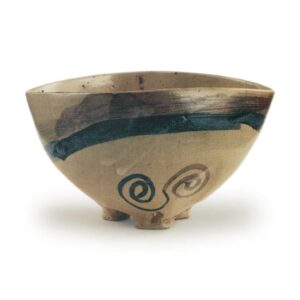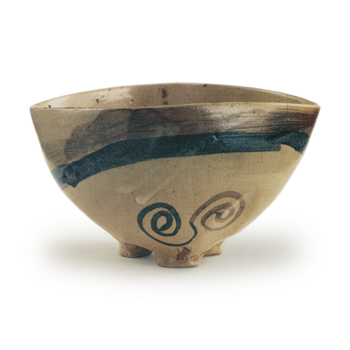

Height: 9.0 to 10.0 cm
Diameter: 13.7 to 16.3 cm
Outside diameter of foot ring: 6.0 cm
Height of foot ring: 0.8 to 1.0 cm
Gohon refers to tea bowls made at a kiln near Busan according to the preferences of Japanese tea masters, and these are further divided into Oribe Gohon, Enshu Gohon, etc. Therefore, Goshomaru, Waridai, Iraho, Kinkai, and Choshimajima are also strictly speaking a type of Gohon, but what is usually called Gohon is From the Kan’ei to the Genroku periods, which were later in the era, the tea bowls made by Genketsu, Mosan and Yaheita of Tsushima at the Wakan kiln in Busan were collectively called Gohon. These are the most recent of the Koryo tea bowls, and the workmanship is generally thin and highly technical. There are quite a few surviving examples, and they come in a variety of types.
Although there are not many tea bowls with paintings, this tea bowl is unusual in both its shape and workmanship, and the painting is also unusual, making it a tea bowl that has never been seen before.
The clay body is hard and tightly fired with only a little iron content, and a relatively thin layer of transparent white glaze is applied to it, with coarse craquelure on the entire inside and outside.
The firing is slightly reductive, and the body is a light gray color. The underglaze iron and gosu (a type of blue pigment) are used to create a free-spirited Oribe-style design. In particular, the bold iron and pale gosu lines that run diagonally around the body are particularly impressive, and I have never seen such a novel and striking design in a picture book before. It is likely that Oribe had a design like this, and that this piece was painted under his influence.
It was made on a potter’s wheel, but the mouth is distorted into a diamond shape, and it has three low, thick legs. There are similar vessels with three legs in the Yi Dynasty ritual vessels, and it is likely that the legs were made based on these.
In any case, the shape of the bowl and the pattern are both unique and rare, and although it was obviously made to be used as a tea bowl, it is also a valuable piece of art.
The inside is plain, the bowl is deep and has a tea-drip well, and there are two scratches on the rim. The sides of the bowl are indented in three places, and the soles of the feet have sand baked into them.
The accompanying item is a plain paulownia wood inner box. On the front of the lid is written in ink “E-Kora-Hishi-Nari-Mitsu-Ashi-Chawan” (Tea bowl with three feet in the shape of a Korean diamond), but the author is unknown. The origin is also unclear.



